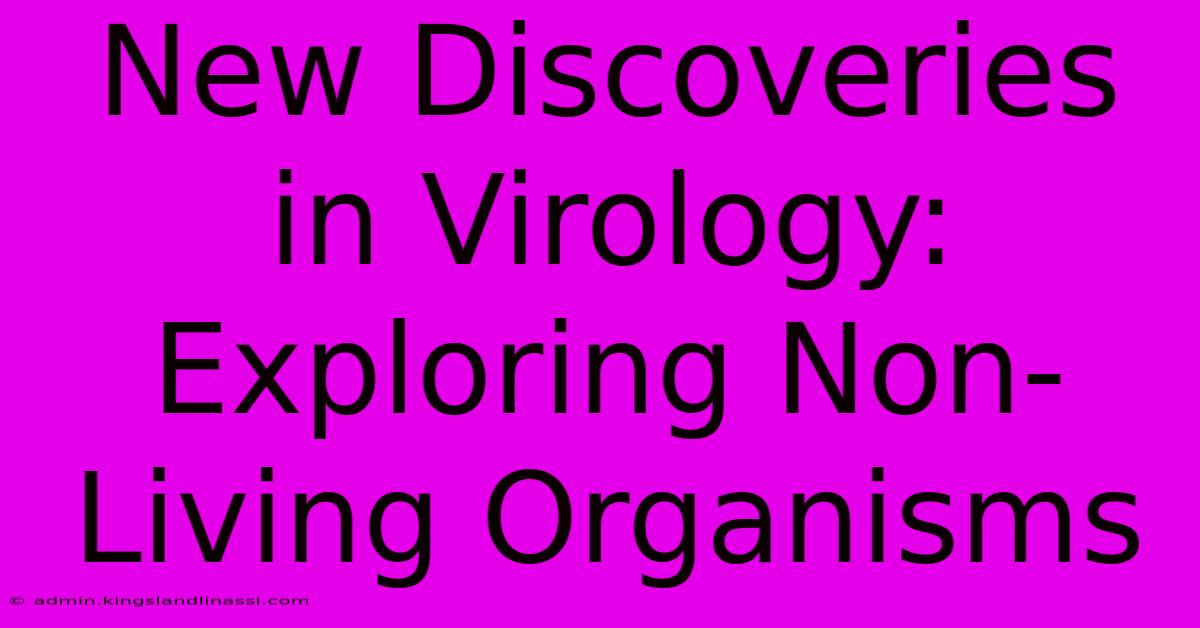New Discoveries In Virology: Exploring Non-Living Organisms

Table of Contents
New Discoveries in Virology: Exploring the Viral World and the Question of Life
The world of virology is constantly evolving, with new discoveries challenging our understanding of viruses and their place in the biological world. While traditionally considered obligate intracellular parasites, recent research pushes the boundaries of what defines a "living" organism, leading to fascinating insights into the nature of viruses themselves. This article delves into these exciting new discoveries, exploring the grey areas between life and non-life as we re-evaluate the viral kingdom.
What are Viruses? A Re-evaluation
Viruses, unlike cellular organisms, lack the independent metabolic machinery necessary for replication. They are essentially genetic material (DNA or RNA) encased in a protein coat, relying entirely on a host cell's resources to reproduce. This fundamental characteristic has traditionally placed them firmly in the "non-living" category. However, recent findings are prompting a reassessment of this classification.
The Case for Non-Living: Key Arguments
- Lack of independent metabolism: Viruses cannot produce their own energy or synthesize proteins independently. They hijack cellular machinery for these functions.
- Inability to reproduce independently: Viral replication requires a host cell; viruses are essentially inert outside of a host.
- No cellular structure: Unlike bacteria or other cellular organisms, viruses lack the complex cellular structures needed for independent life.
The Gray Areas: Challenging the Traditional View
Despite the above, several characteristics of viruses blur the lines between life and non-life:
- Evolutionary dynamics: Viruses evolve through mutation and selection, adapting to their hosts over time, a process traditionally associated with living organisms.
- Genetic complexity: Some viruses possess surprisingly complex genomes, encoding a variety of proteins with intricate functions.
- Viral Mimicry: Some viruses display a remarkable ability to mimic cellular processes, highlighting their sophistication and adaptive capabilities. Giant viruses, for example, exhibit an unexpected degree of complexity, possessing genes previously thought to be exclusive to cellular life.
Recent Discoveries Pushing the Boundaries
Recent advancements in virology have unearthed compelling evidence that further challenges the traditional understanding of viruses:
- Giant viruses: The discovery of giant viruses, such as Mimivirus and Pandoravirus, possessing exceptionally large genomes and complex structures, has significantly impacted the field. These viruses possess genes previously thought to be uniquely cellular, further blurring the line between cellular life and viruses.
- Viral Quasispecies: This concept highlights the rapid evolution and adaptation of viruses within a host. The constant mutation and selection within a viral population create a dynamic cloud of related viral variants, challenging the classical notion of a singular viral "species."
- Viral metagenomics: By analyzing viral genetic material directly from environmental samples, researchers have discovered a vast and largely unexplored viral diversity within various ecosystems, highlighting the crucial roles of viruses in global nutrient cycles and ecological balance.
Implications and Future Research
The ongoing debate over the classification of viruses highlights the limitations of our current understanding of life. These ongoing discoveries necessitate a reassessment of how we define life and the place of viruses within the broader biological framework.
Future research directions include:
- Exploring the origins of viruses: Understanding how viruses originated and their evolutionary relationship to cellular organisms is crucial to fully understanding their nature.
- Investigating the role of viruses in evolution: Viruses are implicated in horizontal gene transfer, potentially influencing the evolution of cellular organisms. Further research is crucial to fully elucidate this role.
- Developing novel antiviral strategies: A deeper understanding of viral biology will help researchers design more effective antiviral strategies.
Conclusion: A Shifting Paradigm
New discoveries in virology are revolutionizing our understanding of viruses. While they might not fit neatly into traditional definitions of life, their complexity, evolutionary dynamics, and ecological importance demand a revised perspective. Future research will undoubtedly uncover further insights into the fascinating world of viruses, continually challenging our understanding of life itself. The debate over whether viruses are alive or not is not merely a semantic one; it's a fundamental question that shapes our understanding of biology and the very nature of life on Earth.

Thank you for visiting our website wich cover about New Discoveries In Virology: Exploring Non-Living Organisms. We hope the information provided has been useful to you. Feel free to contact us if you have any questions or need further assistance. See you next time and dont miss to bookmark.
Featured Posts
-
Waseem Akhtars Son The Future Of Politics
Apr 21, 2025
-
Faisal Qureshi S Daughter Her Journey Of Self Discovery
Apr 21, 2025
-
Hair Goals Achieved With Carols Daughter Goddess Strength
Apr 21, 2025
-
Rokblok Net Worth And Future Investments
Apr 21, 2025
-
Ms Dhonis Net Worth How He Gives Back
Apr 21, 2025
